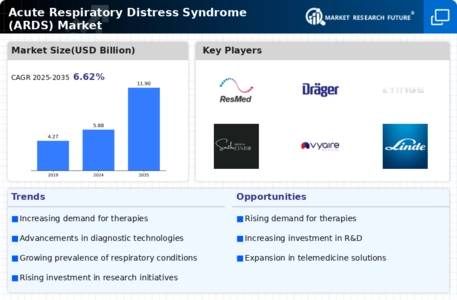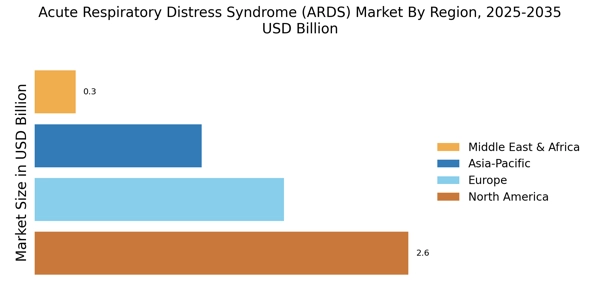Rising Incidence of ARDS
The increasing incidence of Acute Respiratory Distress Syndrome Market (ARDS) is a primary driver for the ARDS Market. Factors such as aging populations and the prevalence of chronic respiratory diseases contribute to this rise. According to recent estimates, ARDS affects approximately 10% of patients in intensive care units, leading to a significant demand for effective treatment options. This growing patient population necessitates advancements in therapeutic interventions and monitoring technologies, thereby propelling market growth. Furthermore, the heightened awareness of ARDS among healthcare professionals and patients alike is likely to foster early diagnosis and intervention, which could further stimulate the ARDS Market. As healthcare systems adapt to these trends, investments in research and development are expected to increase, potentially leading to innovative solutions tailored to ARDS management.
Increased Research Funding
The surge in research funding dedicated to Acute Respiratory Distress Syndrome Market (ARDS) is a significant driver for the ARDS Market. Governments and private organizations are increasingly recognizing the need for innovative therapies and improved management strategies for ARDS. In recent years, funding for ARDS research has seen a notable increase, with millions allocated to clinical trials and studies aimed at understanding the underlying mechanisms of the syndrome. This influx of financial resources is expected to accelerate the development of novel therapeutics and enhance the overall understanding of ARDS. As research progresses, the findings may lead to breakthroughs that could transform treatment paradigms, thereby expanding the ARDS Market. The collaboration between academic institutions and pharmaceutical companies is likely to further amplify these efforts, fostering a robust pipeline of potential therapies.
Growing Awareness and Education
The growing awareness and education surrounding Acute Respiratory Distress Syndrome Market (ARDS) are pivotal in driving the ARDS Market. Increased educational initiatives aimed at healthcare professionals and the general public are fostering a better understanding of ARDS symptoms, risk factors, and treatment options. This heightened awareness is likely to lead to earlier diagnosis and intervention, which could improve patient outcomes. Furthermore, as more healthcare providers become educated about the latest advancements in ARDS management, the demand for innovative therapies and technologies is expected to rise. This trend may also encourage patients to seek medical attention sooner, thereby increasing the overall patient population requiring treatment. Consequently, the ARDS Market may experience growth as healthcare systems adapt to meet the needs of this more informed patient demographic.
Advancements in Medical Technology
Technological advancements play a crucial role in shaping the Acute Respiratory Distress Syndrome Market (ARDS) Market. Innovations in medical devices, such as ventilators and monitoring systems, have significantly improved patient outcomes. For instance, the integration of artificial intelligence in respiratory care has enhanced the precision of treatment protocols. The market for ARDS-related medical devices is projected to grow substantially, driven by the need for more effective and efficient patient management solutions. Additionally, the development of non-invasive monitoring techniques is likely to reduce the burden on healthcare facilities while improving patient comfort. As these technologies evolve, they may lead to a paradigm shift in how ARDS is diagnosed and treated, thereby influencing the overall dynamics of the ARDS Market.
Regulatory Support for New Treatments
Regulatory support for the development of new treatments for Acute Respiratory Distress Syndrome Market (ARDS) is emerging as a key driver in the ARDS Market. Regulatory agencies are increasingly streamlining the approval processes for novel therapeutics, recognizing the urgent need for effective ARDS management solutions. This supportive environment is likely to encourage pharmaceutical companies to invest in research and development, leading to a more diverse range of treatment options. The introduction of expedited pathways for drug approval may facilitate quicker access to innovative therapies for patients suffering from ARDS. As a result, the ARDS Market could witness a surge in new product launches, enhancing competition and potentially improving patient care. This regulatory landscape may also foster collaborations between industry stakeholders, further driving advancements in ARDS treatment.


















Leave a Comment